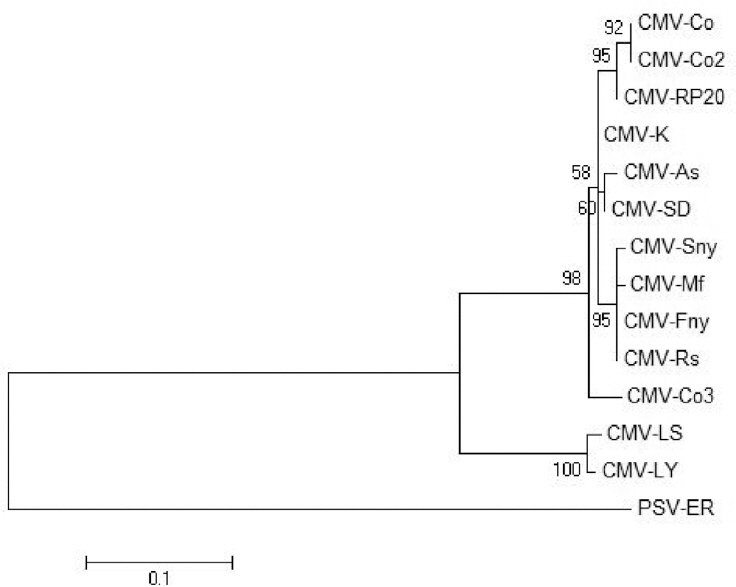Choi, JK, Kwon, SB, Lee, SY and Park, WM 1990. Some properties of two isolates of cucumber mosaic virus isolated from Aster yomena Makino and Commelina communis L. Korean J. Plant Pathol 6: 138-143.
Choi, SK, Choi, JK, Park, WM and Ryu, KH 1999. RT-PCR detection and identification of three species of cucumoviruses with a genus-specifics single pair of primers.
J. Virol. Methods 83: 67-73.


Hong, JS, Park, HS, Ryu, KH and Choi, JK 2009. Comparative anaylysis of coat protein gene of isolates of cucumber mosaic virus isolated from pepper plants in two GMO environmental risk assessment fields.
Res. Plant Dis 15: 165-169.

Kim, MK, Seo, JK, Kwak, HR, Kim, JS, Kim, KH, Cha, BJ and Choi, HS 2014. Molecular genetic analysis of cucumber mosaic virus populations infecting pepper suggests unique patterns of evolution in Korea.
Phytopathology 104: 993-1000.


Owen, J and Palukaitis, P 1988. Characterization of cucumber mosaic virus. I. Molecular heterogeneity mapping of RNA 3 in eight CMV strains.
Virology 166: 495-502.


Palukaitis, P and Garcia-Arenal, F 2003. Cucumoviruses.
Adv. Virus Res 62: 241-323.


Palukaitis, P, Roossinck, MJ, Dietzgen, RG and Francki, RIB 1992. Cucumber mosaic virus.
Adv. Virus Res 41: 281-348.


Roossinck, MJ, Zhang, L and Hellwald, KH 1999. Rearrangements in the 5'nontranslated region and phylogenetic analyses of cucumber mosaic virus RNA 3 indicate radial evolution of three subgroups.
J. Virol 73: 6752-6758.



Suzuki, M, Kuwata, S, Kataoka, J, Masuta, C, Nitta, N and Takanami, Y 1991. Functional analysis of deletion mutants of cucumber mosaic virus RNA3 using an in vitro transcription system.
Virology 183: 106-113.


Valverde, RA 1983. Brome mosaic virus isolates naturally infecting Commelina diffusa and C. communis.
Plant Dis 67: 1194-1196.

Wahyuni, WS, Dietzgen, RG, Hanada, K and Francki, RIB 1992. Serological and biological variation between and within subgroup I and II strains of cucumber mosaic virus.
Plant Pathol 41: 282-297.






 PDF Links
PDF Links PubReader
PubReader Full text via DOI
Full text via DOI Download Citation
Download Citation Print
Print






